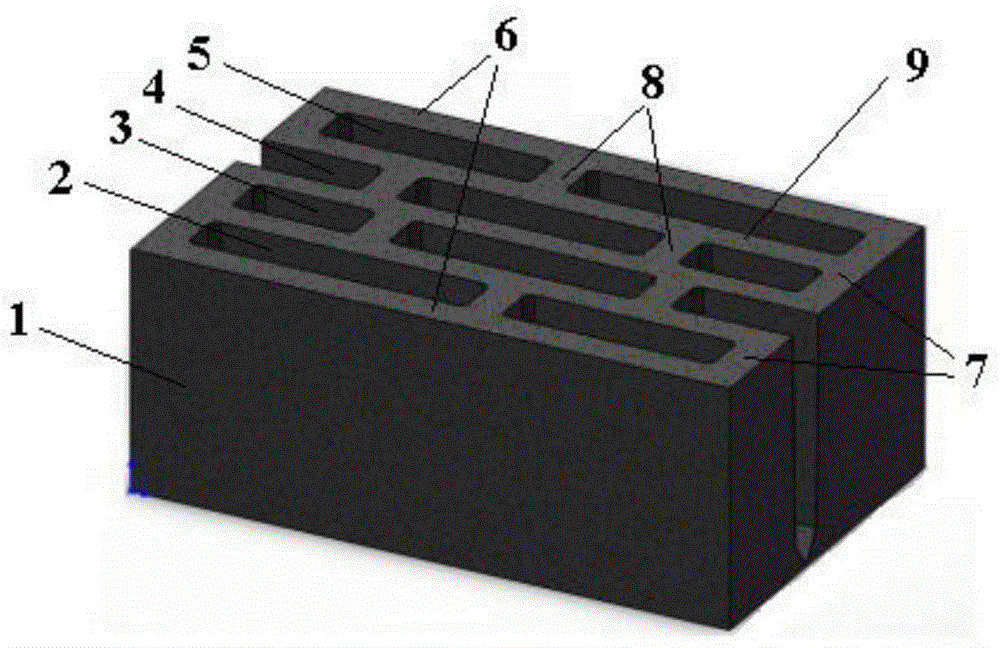Recycled concrete energy-saving thermal-insulating building block and preparation method thereof
A technology of recycled concrete and thermal insulation blocks, applied in thermal insulation, building components, sustainable waste treatment, etc. Improve the masonry strength and shear strength, extend the heat transfer path, and reduce the effect of the cold-hot bridge effect
- Summary
- Abstract
- Description
- Claims
- Application Information
AI Technical Summary
Problems solved by technology
Method used
Image
Examples
Embodiment 1
[0021] Weigh 146kg of ordinary Portland cement with a strength grade of 42.5, 48kg of fly ash, 48kg of slag, 332kg of recycled coarse aggregate, 358kg of recycled fine aggregate, 332kg of cinder, 110kg of water, 44kg of vitrified microbeads, and 0.74 kg of polypropylene fiber. kg, water reducing agent 3.0kg, air-entraining agent 1.8kg. The preparation process is to add recycled aggregate (coarse aggregate 332kg and fine aggregate 358kg), cinder 332kg and 50% cementitious material (cement 73kg, fly ash 24kg, slag 24kg) into a forced mixer and stir for 1min to form a dry powder ready-mixed For concrete, add 0.74kg of polypropylene fiber and 44kg of vitrified microbeads and stir for 1min, then add 50% of water (ie 55kg) and stir for 1min, then add the remaining 50% of cementitious material, remaining 50% of water, and air-entraining agent 1.8kg and 3.0kg of water reducing agent continue to stir for 3 minutes to form a uniform mixture with suitable dry humidity, pour into the mold...
Embodiment 2
[0023] Weigh 150kg of ordinary Portland cement with a strength grade of 42.5, 46kg of fly ash, 40kg of slag, 325kg of recycled coarse aggregate, 350kg of recycled fine aggregate, 340kg of coal cinder, 100kg of water, 40kg of vitrified microbeads, and 0.68 kg of polypropylene fiber. kg, water reducing agent 3.5kg, air-entraining agent 2.0kg. The preparation process is to add recycled aggregate (coarse aggregate 325kg and fine aggregate 350kg), cinder 340kg and 50% cementitious material (cement 75kg, fly ash 23kg, slag 20kg) into a forced mixer and stir for 1min to form a dry powder ready-mixed Concrete, then add 0.68kg of polypropylene fiber and 40kg of vitrified microbeads and stir for 1min, then add 50% of water (ie 50kg) and stir for 1min, then add the remaining 50% of cementitious material, remaining 50% of water, and air-entraining agent 2.0kg and 3.5kg of water reducing agent continue to stir for 4 minutes to form a uniform mixture with suitable dry humidity, pour into th...
Embodiment 3
[0025] Weigh 160kg of ordinary Portland cement with a strength grade of 42.5, 40kg of fly ash, 40kg of slag, 310kg of recycled coarse aggregate, 360kg of recycled fine aggregate, 338kg of cinder, 105kg of water, 47kg of vitrified microbeads, and 0.60 kg of polypropylene fiber kg, water reducing agent 4.0kg, air-entraining agent 2.0kg. The preparation process is to add recycled aggregate (coarse aggregate 310kg and fine aggregate 360kg), cinder 338kg and 50% cementitious material (cement 80kg, fly ash 20kg, slag 20kg) into the mixer and stir for 1min to form dry powder ready-mixed concrete. Then add 0.60kg of polypropylene fibers and 47kg of vitrified microbeads and stir for 1min, then add 50% of water (i.e. 52.5kg) and stir for 1min, then add the remaining 50% of gelling material, remaining 50% of water, and air-entraining agent 2.0 kg and 4.0kg of water reducing agent continue to stir for 3 minutes to form a uniform mixture with suitable dry humidity, pour into the mold, vibr...
PUM
| Property | Measurement | Unit |
|---|---|---|
| Density | aaaaa | aaaaa |
| Thermal resistance | aaaaa | aaaaa |
| Compressive strength | aaaaa | aaaaa |
Abstract
Description
Claims
Application Information
 Login to View More
Login to View More - R&D
- Intellectual Property
- Life Sciences
- Materials
- Tech Scout
- Unparalleled Data Quality
- Higher Quality Content
- 60% Fewer Hallucinations
Browse by: Latest US Patents, China's latest patents, Technical Efficacy Thesaurus, Application Domain, Technology Topic, Popular Technical Reports.
© 2025 PatSnap. All rights reserved.Legal|Privacy policy|Modern Slavery Act Transparency Statement|Sitemap|About US| Contact US: help@patsnap.com

